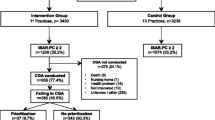Abstract
Background and aims
There is no conclusive evidence that hospital fall prevention programs can reduce the number of falls. We aimed to investigate the effect of a targeted individualized falls prevention program in a geriatric rehabilitation hospital.
Methods
This was a two-stage cluster-controlled trial carried out in five geriatric rehabilitation wards. Participants were 752 patients with mean age 83.2 years. The intervention was a two-phase targeted intervention falls prevention program. The intervention included an assessment of patient’s risk by a risk assessment tool and an individual management that includes medical, behavioral, cognitive and environmental modifications. Patients with moderate risk received additionally orientation guidance, and mobility restriction. Patients determined as high risk were additionally placed under permanent personal supervision. Outcome measures were falls during hospital stay.
Results
In both stages of the trial, intervention and control wards were almost similar at baseline for individual patient characteristics. Overall, 37 falls occurred during the study. No significant difference was found in fall rates during follow-up between intervention and control wards: 1.306 falls per 1000 bed days in the intervention groups and 1.763–1.826 falls per 1000 bed days in the control groups. The adjusted hazard ratio for falls in the intervention groups was 1.36 (95 % confidence interval 0.89–1.77) (P = 0.08) in the first stage and 1.27 (95 % confidence interval 0.92–1.67) (P = 0.12) in the second stage.
Conclusion
These results suggest that in a geriatric rehabilitation hospital a targeted individualized intervention falls prevention program is not effective in reducing falls.

Similar content being viewed by others
References
Nyberg L, Gustafson Y, Patient falls in stroke rehabilitation (1995) A challenge to rehabilitation strategies. Stroke 26:838–842
Teasell R, McRae M, Foley N, Bhardwaj A (2002) The incidence and consequences of falls in stroke patients during inpatient rehabilitation: factors associated with high risk. Arch Phys Med Rehabil 83:329–333
Uden G (1985) Inpatients accidents in hospitals. J Am Geriatr Soc 33:833–841
Ross MK, Egan E, Zaman M, Aziz B, Dewald T, Mohammed S (2012) Falls in the inpatient rehabilitation facility. Phys Med Rehabil Clin N Am 23(2):305–314
Vieira ER, Freund-Heritage R, da Costa BR (2011) Risk factors for geriatric patient falls in rehabilitation hospital settings: a systematic review. Clin Rehabil 25(9):788–799
DeVincenzo DK, Watkins S (1987) Accidental falls in a rehabilitation setting. Rehabil Nurs 12:248–252
Mayo NE, Korner-Bitensky N, Becker R, Georges P (1989) Predicting falls among patients in a rehabilitation hospital. Am J Phys Med Rehabil 68:139–146
Vlahov D, Myers AH, Al-Ibrahim MS (1990) Epidemiology of falls among patients in rehabilitation hospital. Arch Phys Med Rehabil 7:8–12
Dromerick A, Reding M (1994) Medical and neurological complications during inpatient stroke rehabilitation. Stroke 25:358–361
Rochat S, Monod S, Seematter-Bagnoud L, Lenoble-Hoskovec C, Büla CJ (2013) Fallers in postacute rehabilitation have worse functional recovery and increased health services use. J Am Med Dir Assoc 14(11):832–836
Aizen E, Shugaev I, Lenger R (2007) Risk factors and characteristics of falls during inpatient rehabilitation of elderly patients. Arch Gerontol Geriatr 44:1–12
Nyström A, Hellström K (2013) Fall risk 6 weeks from onset of stroke and the ability of the prediction of falls in rehabilitation settings tool and motor function to predict falls. Clin Rehabil 27(5):473–479
Morrison G, Lee HL, Kuys SS, Clarke J, Bew P, Haines TP (2011) Changes in falls risk factors for geriatric diagnostic groups across inpatient, outpatient and domiciliary rehabilitation settings. Disabil Rehabil 33(11):900–907
Aizen E, Zlotver E (2013) Prediction of falls in rehabilitation and acute care geriatric setting. J Clin Gerontol Geriatr 4(2):57–61
Oliver D, Daly F, Martin FC, McMurdo ME (2004) Risk factors and risk assessment tools for falls in hospital in-patients: a systematic review. Age Ageing 33(2):122–130
Vassallo M, Vignaraja R, Sharm JC, Briggs R, Allen SC (2004) Predictors for falls among hospital inpatients with impaired mobility. J R Soc Med 97(6):266–269
Sze KH, Wong E, Leung HY, Woo J (2001) Falls among chinese stroke patients during rehabilitation. Arch Phys Med Rehabil 82:1219–1225
Chu LW, Pei CK, Chiu A, Liu K, Chu MM, Wong S, Wong A (1999) Risk factors for falls in hospitalized older medical patients. J Gerontol A Biol Sci Med Sci 54(1):M38–M43
Gluck T, Wientjes HJ, Rai GS (1996) An evaluation of risk factors for in-patient falls in acute and rehabilitation elderly care wards. Gerontology 42(2):104–107
Oliver D, Hopper A, Seed P (2000) Do hospital fall prevention programs work? A systematic review. J Am Geriatr Soc 48:1679–1689
Gillespie L, Gillespie W, Robertson M, Lamb S, Cumming R, Rowe B (2003) Interventions for preventing falls in elderly people. Cochrane Database Syst Rev 4:CD000340
Vieira ER, Berean C, Paches D, Caveny P, Yuen D, Ballash L, Freund-Heritage R (2013) Reducing falls among geriatric rehabilitation patients: a controlled clinical trial. Clin Rehabil 27(4):325–335
Hempel S, Newberry S, Wang Z, Booth M, Shanman R, Johnsen B, Shier V, Saliba D, Spector WD, Ganz DA (2013) Hospital fall prevention: a systematic review of implementation, components, adherence, and effectiveness. J Am Geriatr Soc 61(4):483–494
Verheyden GS, Weerdesteyn V, Pickering RM, Kunkel D, Lennon S, Geurts AC, Ashburn A (2013) Interventions for preventing falls in people after stroke. Cochrane Database Syst Rev 31(5):CD008728
Cameron ID, Gillespie LD, Robertson MC, Murray GR, Hill KD, Cumming RG, Kerse N (2012) Interventions for preventing falls in older people in care facilities and hospitals. Cochrane Database Syst Rev 12:CD005465
Oliver D (2006) Assessing the risk of falls in hospital. Time for a rethink? Can J Nurs Res 38:89–94
Conflict of interest
The authors declare no conflict of interest.
Author information
Authors and Affiliations
Corresponding author
Rights and permissions
About this article
Cite this article
Aizen, E., Lutsyk, G., Wainer, L. et al. Effectiveness of individualized fall prevention program in geriatric rehabilitation hospital setting: a cluster randomized trial. Aging Clin Exp Res 27, 681–688 (2015). https://doi.org/10.1007/s40520-015-0330-7
Received:
Accepted:
Published:
Issue Date:
DOI: https://doi.org/10.1007/s40520-015-0330-7




